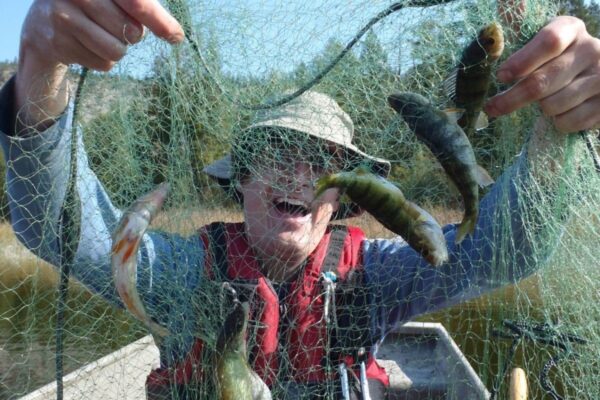Yellow perch
About This Species
Yellow perch (American perch, Striped perch) are a fish that have been intentionally released in British Columbia as stock fish and from aquariums and private ponds, and accidentally spread by boats and in bait buckets. They are native and widespread East of the Rocky Mountains, from Alberta to Nova Scotia and North to the Northwest Territories.
Yellow perch are predators of other fish species, insects, and tadpoles. They reproduce quickly and may overwhelm and outcompete native predatory fish for food and habitat. They’ve been shown to impact salmon growth and survival, as well as carriers of parasites. Yellow perch are designated as a Regional Containment/Control species by the BC Provincial Priority Invasive Species List.
How to Identify
Yellow perch are 10-25 cm long, with an olive green back with 7 thick dark stripes and a silver belly. They have two dorsal fins, a forked tail, and a small hump just behind the head.

Take Action
Prevention is the best approach.
-
If you need advice about invasive species on your property or you are concerned about reported invasives in your local area, contact your local government or regional invasive species organization.
PREVENTION TIPS
It is illegal to move fish between waterways in BC. The use of live finfish as bait is strictly prohibited in BC.

Don't Let It Loose
Learn about best practices
Invasive species are plants, animals or other organisms that are not native to BC, and have serious impacts on our environment, economy and society. Never release your plants and animals into the wild or dump aquariums or water garden debris into rivers, streams, lakes or storm sewers!

Clean, Drain, Dry
Learn about best practices
The Clean Drain Dry program empowers you to help reduce the spread of invasive plants and organisms to BC waters by following the clean, drain, dry procedure on all watercraft and equipment.
REPORT TO PROTECT BC’S BIODIVERSITY

Use the app
Observe and report to protect BC’s biodiversity

Report through this website
Use our form to tell us what you’re seeing and where.




